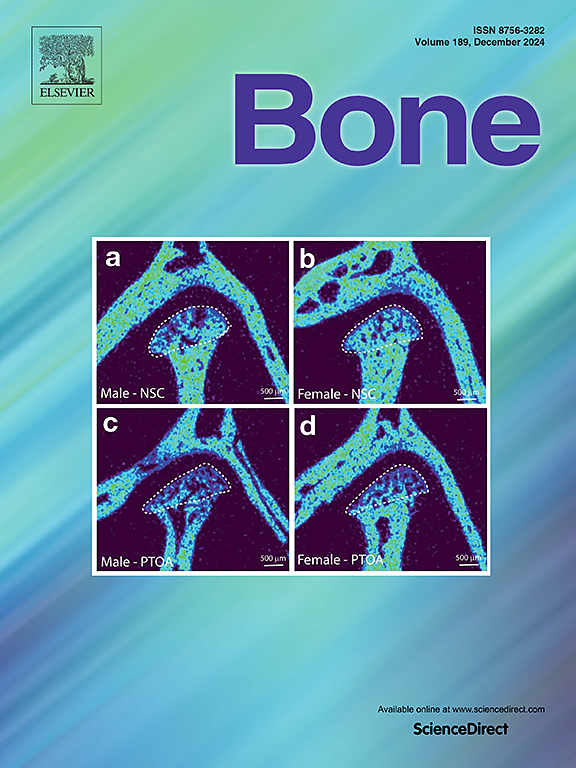2型糖尿病患者表现出延迟但耦合的骨重塑,维持与健康对照相当的皮质孔隙度:经髂骨活检的组织形态学分析。
IF 3.5
2区 医学
Q2 ENDOCRINOLOGY & METABOLISM
引用次数: 0
摘要
目的:久治不愈的 2 型糖尿病(T2D)患者骨折风险增加。高分辨率外周定量 CT 扫描显示,并发微血管疾病(MVD)的 T2D 患者皮质孔隙率较高。我们研究了在 T2D 并发 MVD 的患者中,皮质骨吸收是否会导致骨形成不足:我们从门诊和公共广告中招募了 35 名患有 T2D 的成年男性和女性。所有参与者之前至少有一次 c 肽大于 700,GAD 抗体检测呈阴性,13 人有已知的微血管疾病状况。采集经髂嵴骨活检组织进行组织形态分析。使用 HbA1c 评估血糖控制情况。此外,还纳入了 10 名无 T2D 患者的经髂骨标本作为对照:经过质量评估后,来自 30 名 T2D 患者和 10 名对照组的样本被用于皮质骨重塑的组织形态学分析。最终研究对象包括 23 名男性和 7 名绝经后女性,T2D-MVD 组平均年龄为 65.8 岁(CI95% 61.2-70.3),T2D + MVD 组平均年龄为 65.2 岁(CI95% 59.6-70.9),T2D 病程平均为 16.9 年。17人患有中风(57%)。对照组包括 5 名男性和 5 名女性,平均年龄为 64.7 岁(CI95% 58.5-70.9)。有 MVD 和没有 MVD 的病例中,皮质毛孔的面积、直径和密度相同,但毛孔直径低于对照组。与对照组相比,后天性心脏病患者的侵蚀形成孔明显增多,但两组之间侵蚀形成孔的比例没有明显差异。在静止孔隙/骨质中,T2D 组的骨质直径和壁厚大于对照组:结论:并发骨髓增生异常的 T2D 患者的皮质骨孔隙率并没有增加。结论:无论是否存在血管内膜异位症,T2D 患者的皮质骨孔隙率并未增加,但侵蚀形成的孔隙增加,骨小梁直径增大,这与 T2D 患者的逆转-吸收阶段略有延长有关。本文章由计算机程序翻译,如有差异,请以英文原文为准。
Type 2 diabetes patients exhibit delayed but coupled bone remodelling, maintaining cortical porosity comparable to healthy controls: A histomorphometric analysis of trans-iliac bone biopsies
Objective
Fracture risk is increased in longstanding type 2 diabetes (T2D). High-resolution peripheral quantitative CT scans have demonstrated higher cortical porosity in T2D complicated by microvascular disease (MVD). We investigated if cortical bone resorption is followed by inadequate bone formation in individuals with T2D complicated by MVD.
Methods
Thirty-five adult men and women with T2D were recruited from outpatient clinics and through public advertisement. All participants had at least one previous measure of c-peptide >700, a negative GAD antibody test, and 13 had known microvascular disease status. Trans iliac crest bone biopsies were collected for histomorphometric analysis. Glucose control was assessed using HbA1c. Additionally, trans iliac bone specimens from 10 individuals without T2D were included as controls.
Results
Following quality assessment, samples from 30 T2D and 10 controls were used for histomorphometric analyses of cortical bone remodelling. The final study population included 23 men and 7 postmenopausal women with a mean age of 65.8 years for the T2D-MVD group (CI95% 61.2–70.3) and 65.2 years in the T2D + MVD group (CI95% 59.6–70.9), and a mean T2D disease duration of 16.9 years. Seventeen had MVD (57 %). The controls included 5 men and 5 women with a mean age of 64.7 years (CI95% 58.5–70.9). The area, diameter, and density of cortical pores were the same in cases with and without MVD, but the pore diameter was lower than controls. While T2D had significantly more eroded-formative pores compared to controls, there were no significant differences in the proportion of eroded and formative pores between the groups. In quiescent pores/osteons, the osteon diameter and wall thickness were larger in T2D groups than controls.
Conclusion
Cortical bone porosity was not increased in individuals with T2D complicated by MVD. However, an enhanced prevalence of eroded-formative pores and increased osteon diameter concur with a slightly prolonged reversal-resorption phase in T2D irrespective of the presence of MVD.
求助全文
通过发布文献求助,成功后即可免费获取论文全文。
去求助
来源期刊

Bone
医学-内分泌学与代谢
CiteScore
8.90
自引率
4.90%
发文量
264
审稿时长
30 days
期刊介绍:
BONE is an interdisciplinary forum for the rapid publication of original articles and reviews on basic, translational, and clinical aspects of bone and mineral metabolism. The Journal also encourages submissions related to interactions of bone with other organ systems, including cartilage, endocrine, muscle, fat, neural, vascular, gastrointestinal, hematopoietic, and immune systems. Particular attention is placed on the application of experimental studies to clinical practice.
 求助内容:
求助内容: 应助结果提醒方式:
应助结果提醒方式:


